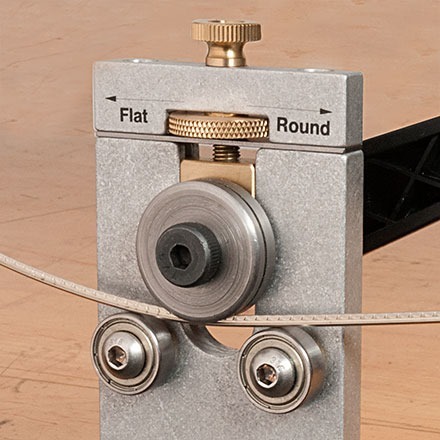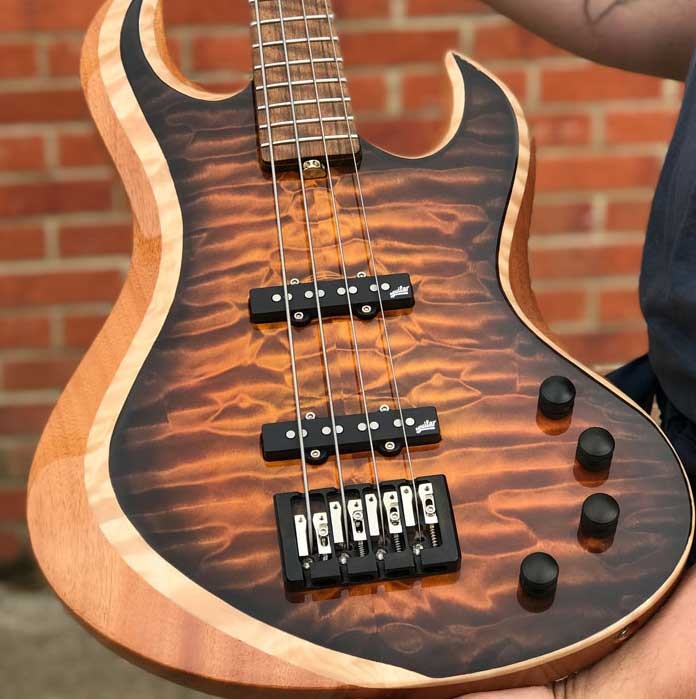The fret wire used here was nickel/silver. It was of the narrow/tall style like a banjo or Martin guitar. Height is .040 tall and .080 wide.
Neck prep
The fingerboard has been radiused and is flat at this point.
All fret slots are deep enough to accept the tang of the fret wire chosen.
The fingerboard is fully finish sanded up to 220 grit.
Preparing fret wire
This can be done using a simple manual hand crank fret wire rolling machine. A common machine to use is called the FretBender:


When fret bending, you can in fact temper the steel by rolling your frets anywhere from 7 to 10 more times more compared to just once. What this does is make your fret steel harder. For some players, especially those that use their instrument for heavy gigging and/or heavy use of slap/pop or note bending or tapping, harder frets means they will last longer.
Should you always harden your frets? Given that it makes frets last longer and it only takes but a moment, yes.
Tip: It is recommended you over-radius your fret wire slightly (example: if you have a 10″ radius, have your wire radius at 9″) for the reason that when seating the wire into the fingerboard, the ends of the wire will seat in first, then naturally flatten as the remainder of the wire seats to the board. This locks the fret ends in place and prevents raised fret ends.
Notes on workbench style for use in seating fret wire
The best advice we can give here concernign the workbech style to use for seating fret wire is this:
First, make sure it is a bench where you work can be adequately secured, meaning to not move around while seating fret wire.
Second, make sure the bench is the type that has the least rebound to it, which can also be described as “how much bounce it has.” You do not want a bench that will bounce back too much when seating wire into a board, else the work will be potentially ruined.
In other words, use a sturdy, as-bounce-free-as-possible work bench.
Installing fret wire
The method of fret installation we will use is seating them in using a hammer. While very old-school, it is the fastest and most efficient way to go about it.
There is a specific hammer for use with frets, and it is simply called a fret hammer. However, there are two types of hammers available. One which is very inexpensive at usually under 5 dollars, and another type that is over 20 dollars. The over-20-dollar hammer is called a deadblow fretting hammer, and the reason it is priced as it is is because the head of the hammer is filled with buckshot. What this does is prevent hammer recoil, which is adventageous you prefer more precise strikes when seating your fret wire. Which hammer should you use? That is up to you. You can essentially get the same performance out of both hammer types. In the end, technique is what matters more than anything else, regardless of what hammer type is used.
The importance of swinging small, tapping and not banging
Disclaimer: The only way to really see how frets are hammered into position is to watch someone do it, and/or be trained by a luthier personally on how to seat frets into a fingerboard.
Ordinarily, the way most people hammer things into other things is to take a long swing, bang, and then let the hammer recoil (as in bounce) back, then repeat until the the whatever-it-is is driven fully.
Seating frets does not work like that. Instead of purposely using a long swing and using the recoil/bounce, you instead use a short throw with a small push on the end of the swing.
Typically, it will take 10 to 15 taps to get a fret seated into the fingerboard. The initial taps get the ends seated; the final taps seat the middle of the fret.
Where are the rest of the build steps?
You can view them all here.




I have found that using fret-press cauls (like the ones Stew-Mac sell) in a drill press, works just as quickly as a hammer and results in fewer dented frets and a much easier leveling job afterwards.